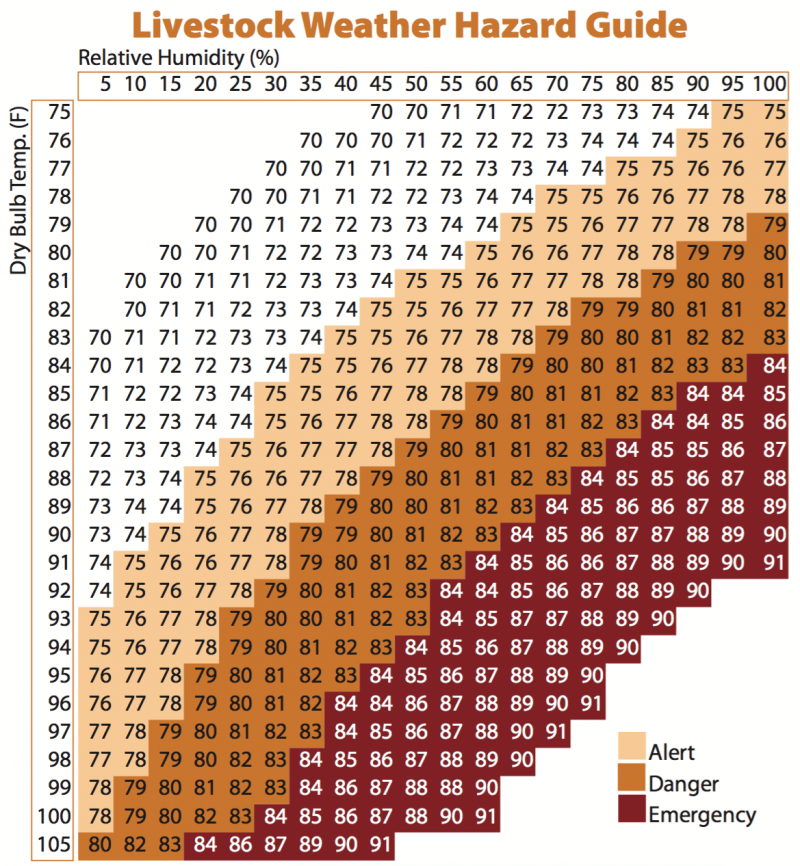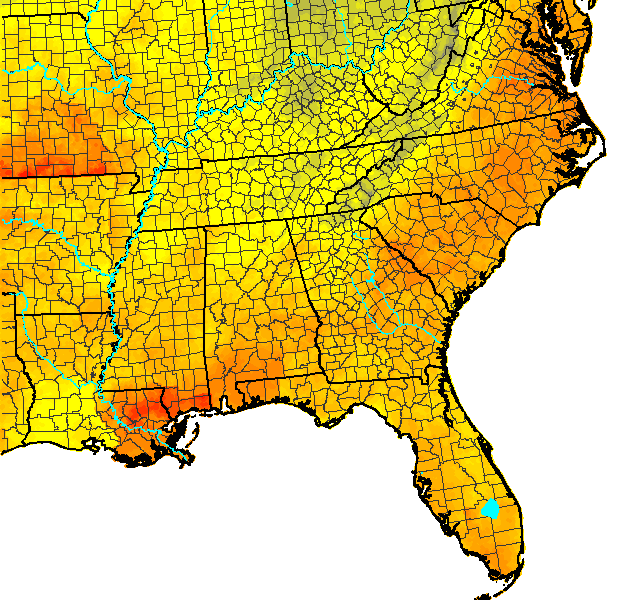
The negative effects of heat stress can be greatly reduced if cattle have access to plenty of shade. This picture was taken almost a year ago, before Hurricane Michael. Unfortunately, many of the shade trees in the picture are no longer standing. Photo Credit: Mark Mauldin
As we close in on August, the unrelenting heat and humidity impacts everything we do on and off the farm. We know how serious the heat can affect us, and we make the necessary efforts to deal with it. It is also important that we make the necessary efforts to ensure that our cattle are able to deal with the heat.
Generally speaking, Bos taurus cattle (European breeds) do not handle heat very well. Cattle have a very limited ability to sweat and struggle to effectively dissipate heat. They begin to experience heat stress as temperatures reach the upper 70s. As with all animals, if cattle get too hot for extended periods, the effects can be quite severe, including death. While clearly producers need to take steps to prevent these extreme cases of heat stress, there are more subtle, performance robbing effects of heat stress, like reduced dry matter (DM) intake, that producers need to be aware of.

The Livestock Weather Hazard Guide shows the risk of heat stress at various temperature and humidity levels. Based on the guide, Florida cattle are at an elevated risk for heat stress all throughout the summer. Image from Monitor and Manage Heat Stress, published by the Noble Research Institute
When cattle are heat stressed they eat less. Late in the summer, when it is the hottest, our perennial pastures tend to decline in quality making maximum DM intake crucial to ensuring the animal’s nutritional demands are met. If nutritional demands are not met, the animal’s body condition score will begin to decline, eventually causing all aspects of performance (reproductive efficiency, average daily gain, milk production, etc.) to suffer.
It gets hot every summer, but he situation can be managed to reduce the severity of the heat stress cattle must endure. When cattle have access to shade and water, they are able to cool off and reduce the effects of heat stress, including the unwanted reduction in DM intake.

An example Heat Stress Forecast Map generated on 7/25, showing the predicted heat stress risk for 7/29. The maps are published by the US Meat Animal Research Center, a part of USDA ARS. Warmer colors indicate increasing risk of heat stress. There is also a smart phone app available that can provide the current heat stress risk level for you area.
Shade
Cattlemen know that having adequate shade is important. Unfortunately, for those of you that were in the path of Hurricane Michael, many (if not all) of your shade trees were destroyed. It is important that you recognize how this reduction in shade (and the corresponding increase in heat stress) can adversely affect the performance of our herds. Take the time to reevaluate the shade left in your pastures, and make the necessary changes.
Each mature cow needs about 40 square feet of shade. Remember, shade moves with the sun and the cows need access to adequate shade all day. Even if there is some shade still available, the amount and distribution of the remaining shade may be an issue. For rotational grazing systems, be sure that all paddocks have adequate shade. In continuous grazing systems, shade needs to be distributed, so that cattle utilize the entire pasture.
If there is no longer adequate shade available in your pastures, it may be necessary to utilize artificial shade structures. These structures come in many forms and can be permanent or portable. In most grazing situations, portable structures with shade-cloth tops are the most effective. They can be moved from pasture to pasture providing the necessary shade for a much smaller investment than building a permanent structure in each pasture. Because they are portable, they can reduce the negative impacts often associated with permanent high traffic areas. They can also be positioned to help maximize efficient pasture utilization. Shade-cloth is preferable to solid roofing material, because the shade-cloth can block a substantial portion of the sunlight while still allowing for air flow.
There are manufactured shade structures on the market (just search “cattle shade structures” online), and also a numboer of DIY plans floating around as well. The truth is there are no cheap options, and you generally get what you pay for in terms of effectiveness, longevity, and convenience. That said, adequate shade is a necessity, so if Hurricane Michael took your trees, shade structures may just be a new part of the “cost of doing business“. Replanting trees is also an option (I would try to keep them away from your fences), but it will take several years before newly planted trees provide any appreciable shade, and they also need to be protected from grazing and rubbing. Cattle need to cool off now.
Hurricane Michael changed a lot, including the amount of shade available in many pastures. Understandably, shade for your cows has not been a priority – you’ve had homes to repair, barns to rebuild, and LOTS of fences to patch. It’s hot now, and if you don’t address our lack of shade it will cost you. The costs will show up gradually over time as reductions in herd performance, like fewer cows breeding back on time and reduced weaning weights.

Shade structure at the NFREC in Marianna. It was used in a study looking at the Impact of Shade on Cattle Performance in the Florida Panhandle (Photo by Lautaro Rostoll).
Water
Cattle water requirements increase as temperatures rise. Unrestricted access to clean, fresh water (as opposed to hot, muddy pond water) is vitally important. “Ambient temperatures in the mid-90s can increase cattle water requirements by 2.5 times, as compared to 70° F. Water trough capacity and refill rate become very important in this situation. Most experts agree that cattle need 3 linear inches of water tank space per head during hot weather. Make sure that refill rates are adequate, so that cattle intake does not exceed refill capacity.” (Heat Stress and Beef Cattle)
When it’s hot, if given the option, cattle will stand in water to cool themselves. Cattle loafing can have substantial negative effects on the water quality of the water body. This practice is strongly discouraged in any flowing water, wetland, lake, or sinkhole. See the FDACS Water Quality BMP Manual for Cow/Calf Operations for more details.
In hot conditions, when the amount of shade or water trough space is limited the social hierarchy of the herd will become evident. Dominant cows can prevent subordinate cows from having sufficient access to the shade and/or water. Cows don’t share well, so be sure there is plenty of space available.
Even with adequate shade and water many cattle will still experience heat stress during the hottest parts of the day. However, the cooler they stay the faster they will cool down to the point they want to eat again, enabling them to more effectively take advantage of normal temperature fluctuations. In other words, they will start grazing earlier in the evenings and be more apt to take advantage of cloudy (cooler) periods. The increased grazing time will help to keep DM intake at a level necessary to maintain acceptable performance.
Beyond providing the herd access to adequate shade and water, cattlemen can combat the negative effects of heat stress by selecting cattle that are better adapted to hot and humid conditions, so consider the impact of heat stress when making future management decisions (type of bull, timing of breeding/calving, weaning, etc.). More to come on these topics in my next article. For assistance developing a plan to help your cattle deal with the heat contact your county’s UF/IFAS Agricultural Extension Agent.
For more information, use the following links:
Heat Stress and Beef Cattle
Monitor and Manage Heat Stress
Dealing With Heat Stress in Beef Cattle Operations
Shade Options for Grazing Cattle
The Impact of Shade on Cattle Performance in the Florida Panhandle
Portable Cattle Shade Plan – University of Missouri
NRCS Livestock Shelter Structure
- Peanut Maturity Update – 10/9/25 - October 10, 2025
- Fall Can be a Great Time for Vegetation Management - October 3, 2025
- Peanut Maturity Update – 9/25/25 Edition - September 26, 2025
